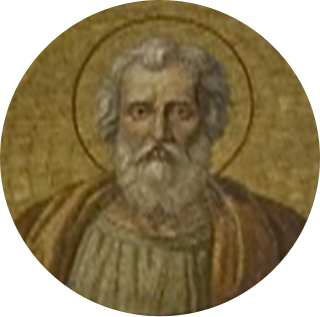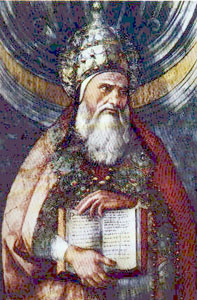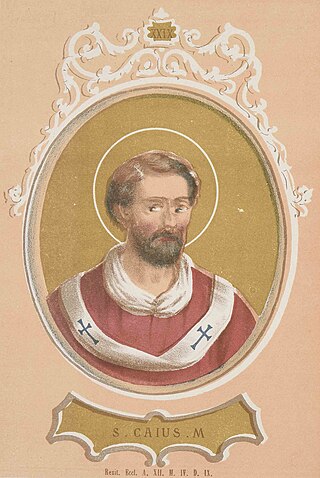
Antipope Felix II, an archdeacon of Rome, was installed as Pope in 355 AD after the Emperor Constantius II banished the reigning Pope, Liberius, for refusing to subscribe to a sentence of condemnation against Saint Athanasius.

Pope Alexander I was the bishop of Rome from about 108/109 to 116/119. Some believe he suffered martyrdom under the Roman emperor Trajan or Hadrian.

Pope Miltiades, also known as Melchiades the African, was the bishop of Rome from 311 to his death on 10 or 11 January 314. It was during his pontificate that Emperor Constantine the Great issued the Edict of Milan (313), giving Christianity legal status within the Roman Empire. The pope also received the palace of Empress Fausta where the Lateran Palace, the papal seat and residence of the papal administration, would be built. At the Lateran Council, during the schism with the Church of Carthage, Miltiades condemned the rebaptism of apostatised bishops and priests, a teaching of Donatus Magnus.

Pius I was the bishop of Rome from c. 140 to his death c. 154, according to the Annuario Pontificio. His dates are listed as 142 or 146 to 157 or 161, respectively. He is considered to have opposed both the Valentinians and Gnostics during his papacy. He is considered a saint by the Catholic Church with a feast day in 11 July, but it is unclear if he died as a martyr.

Pope Sixtus II, also written as Pope Xystus II, was bishop of Rome from 31 August 257 until his death on 6 August 258. He was killed along with seven deacons, including Lawrence of Rome, during the persecution of Christians by the Emperor Valerian.

Pope Urban I, also known as Saint Urban (175?–230), was the bishop of Rome from 222 to 23 May 230. He was born in Rome and succeeded Callixtus I, who had been martyred. It was believed for centuries that Urban I was also martyred. However, recent historical discoveries now lead scholars to believe that he died of natural causes.

Pope Stephen I was the Bishop of Rome from 12 May 254 to his death on 2 August 257. He was later canonized as a saint and some accounts say he was killed while celebrating Mass.

Pope Lucius I was the bishop of Rome from 25 June 253 to his death on 5 March 254. He was banished soon after his consecration, but gained permission to return. He was mistakenly classified as a martyr in the persecution by Emperor Valerian, which did not begin until after Lucius' death.

Pope Anacletus, also known as Cletus, was the bishop of Rome, following Peter and Linus. Anacletus served between c. AD 80 and his death, c. AD 92. Cletus was a Roman who, during his tenure as pope, ordained a number of priests and is traditionally credited with setting up about twenty-five parishes in Rome. Although the precise dates of his pontificate are uncertain, he "...died a martyr, perhaps about 91". Cletus is mentioned in the Roman Canon of the mass; his feast day is April 26.

Pope Pontian was the bishop of Rome from 21 July 230 to 28 September 235. In 235, during the persecution of Christians in the reign of the Emperor Maximinus Thrax, Pontian was arrested and sent to the island of Sardinia.

Pope Caius, also called Gaius, was the bishop of Rome from 17 December 283 to his death in 296. Little information on Caius is available except that given by the Liber Pontificalis, which relies on a legendary account of the martyrdom of Susanna of Rome for its information. According to legend, Caius baptized the men and women who had been converted by Tiburtius and Castulus. His legend states that Caius took refuge in the catacombs of Rome and died a martyr.

Pope Marcellinus was the bishop of Rome from 30 June 296 to his death in 304. A historical accusation was levelled at him by some sources to the effect that he might have renounced Christianity during Emperor Diocletian's persecution of Christians before repenting afterwards, which would explain why he is omitted from lists of martyrs. The accusation is rejected, among others, by Augustine of Hippo. He is today venerated as a saint in the Catholic Church and in the Serbian Orthodox Church.

Pope Mark was the bishop of Rome from 18 January to his death on 7 October 336.

Pope Simplicius was the bishop of Rome from 468 to his death. He combated the Eutychian heresy, ended the practice of consecrating bishops only in December, and sought to offset the effects of Germanic invasions.

Martinian and Processus were Christian martyrs of ancient Rome. Neither the years they lived nor the circumstances of their deaths are known. They are currently buried in St. Peter's Basilica in Rome.

Saint Juvenal is venerated as the first Bishop of Narni in Umbria. Historical details regarding Juvenal's life are limited. A biography of Juvenal of little historical value, written after the seventh century, states that Juvenal was born in Africa, was ordained by Pope Damasus I, was the first bishop of Narni, and was buried in the Porta Superiore on the Via Flaminia on August 7, though his feast day was celebrated on May 3. This Vita does not call him a martyr but calls him a confessor. The martyrologies of Florus of Lyon and Ado describe Juvenal as a bishop and confessor rather than as a martyr.

Felicitas of Rome, also anglicized as Felicity, is a saint numbered among the Christian martyrs. Apart from her name, the only thing known for certain about this martyr is that she was buried in the Cemetery of Maximus, on the Via Salaria on a 23 November. However, a legend presents her as the mother of the seven martyrs whose feast is celebrated on 10 July. The Eastern Orthodox Church celebrates their martyrdom on 25 January.

Saint Hermes, born in Greece, died in Rome as a martyr in 120, is venerated as a saint by the Catholic Church and the Eastern Orthodox Church. His name appears in the Martyrologium Hieronymianum as well as entries in the Depositio Martyrum (354). There was a large basilica over his tomb that was built around 600 by Pope Pelagius I and restored by Pope Adrian I. A catacomb in the Salarian Way bears his name.

Felicissimus and Agapitus were two of the six deacons of Pope Sixtus II who were martyred with him on or about 6 August 258, Felicissimus and Agapitus on the same day as the Pope. The seventh deacon, Lawrence of Rome, was martyred on 10 August of the same year.

Agapitus is venerated as a martyr saint, who died on August 18, perhaps in 274, a date that the latest editions of the Roman Martyrology say is uncertain.




















